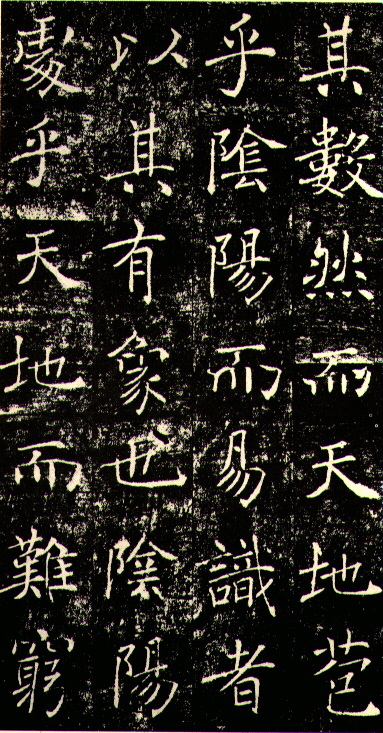- Regular script
Infobox Writing system
name=Regular script
type=Logographic
languages=Old Chinese ,Middle Chinese ,Spoken Chinese
time=Bronze Age China ,Iron Age China , Present day
fam1=Oracle Bone Script
fam2=Seal Script
fam3=Clerical Script
children=Kanji Kana Hanja Zhuyin Simplified Chinese Chu Nom Khitan script Jurchen script Tangut script
unicode
iso15924=Hani, Hans, HantThe regular script or standard script, or in Chinese kaishu (zh-stp|s=楷书|t=楷書|p=kǎishū) and Japanese kaisho, also commonly known as standard regular (正楷), is the newest of theChinese calligraphy styles (appearing by theCao Wei dynasty ca. 200 CE and maturing stylistically around the7th century ), hence most common in modern writings and publications (after the non-calligraphic printing Song Ti). It is also occasionally known as true script (真書 zhēnshū) and standard script (正書 zhèngshū).Standard script came into being between the Eastern Hàn and Cáo Wèi dynasties [Qiú 2000, p.143] , and its first known master was Zhōng Yáo (sometimes also read Zhōng Yóu; 鍾繇) [Qiú 2000, p.142] , who lived in the E. Hàn to Cáo Wèi period, ca 151-230 CE. He is known as the “father of standard script”, and his famous works include the Xuānshì Biǎo (宣示表), Jiànjìzhí Biǎo (薦季直表), and Lìmìng Biǎo (力命表). Qiú Xīguī (2000, p.143) describes the script in Zhong’s Xuānshì Biǎo as::“…clearly emerging from the womb of early period semi-cursive script. If one were to write the tidily written variety of early period semi-cursive script in a more dignified fashion and were to use consistently the pause technique (dùn 頓, used to reinforce the beginning or ending of a stroke) when ending horizontal strokes, a practice which already appears in early period semi-cursive script, and further were to make use of right-falling strokes with thick feet, the result would be a style of calligraphy like that in the “Xuān shì biǎo”.
However, other than a few literati, very few wrote in this script at the time; most continued writing in neo-clerical script, or a hybrid form of semi-cursive and neo-clerical [Qiu 2000, p.143] . Standard script did not become dominant until the early
Southern and Northern Dynasties , in the5th century ; this was a variety of standard script which emerged from neo-clerical as well as from Zhong Yao's standard script [Qiu 2000, p.146] , and is called "Wei regular" (魏楷 Weikai). Thus, standard script had parentage in early semi-cursive as well as neo-clerical scripts.
right|200px|thumb|"Sheng Jiao Xu" by Chu Suiliang: calligraphy of the Kaishu style. 其數然而天地苞/乎陰陽而易識者/以其有象也陰陽/處乎天地而難窮The script is considered to have matured stylistically during theTang Dynasty , with the most famous and oft-imitated regular script calligraphers of that period being:
* The early Tang four great calligraphers (初唐四大家):
**Ouyang Xun (欧阳询)
**Yu Shinan (虞世南)
**Chu Suiliang (褚遂良)
**Xue Ji (薛稷)
* "Yan-Liu" (“顏柳”)
**Yan Zhenqing (颜真卿)
**Liu Gongquan (柳公权)Those regular script characters with width (or length) larger than 5 cm (2 in) is usually considered larger regular script, or dakai (大楷), and those smaller than 2 cm (0.8 in) usually small regular script, or xiaokai (小楷). Those in between are usually called medium regular script, or zhongkai (中楷). Or are compared in relation to those around.
Beginners often are recommended to start with the
Eight Principles of Yong , which are said to contain the fundamentals of most, if not all, of the regular script calligraphy.Notable artifacts with the Regular Scripts include:
* "The Records of Yao Boduo Sculpturing" (姚伯多造像記) during theSouthern and Northern Dynasties
* The Tablet of Guangwu General (廣武將軍碑) during theSouthern and Northern Dynasties
* The Tablet of Longzang Temple (龍藏寺碑) of theSui Dynasty
* "Tombstone-Record of Sui Xiaoci" (蘇孝慈墓誌) of theSui Dynasty
* "Tombstone-Record of Beauty Tong" (董美人墓誌) of theSui Dynasty The
Zhuyin used to annotate texts, although not true Chinese characters, are virtually always written in the regular script style as well.References
*Qiú Xīguī (2000). Chinese Writing. Translation of 文字學概論 by Mattos and Norman. Early China Special Monograph Series No. 4. Berkeley: The Society for the Study of Early China and the Institute of East Asian Studies, University of California, Berkeley. ISBN 1-55729-071-7.
Wikimedia Foundation. 2010.
